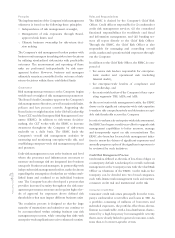American Express 2004 Annual Report Download - page 46
Download and view the complete annual report
Please find page 46 of the 2004 American Express annual report below. You can navigate through the pages in the report by either clicking on the pages listed below, or by using the keyword search tool below to find specific information within the annual report.
Market exposure in TRS is a byproduct of the delivery
of products and services to cardmembers. Interest rate
risk is generated by funding cardmember charges and
fixed rate loans with variable rate borrowings. Such
assets and liabilities generally do not create naturally
offsetting positions as it relates to basis, re-pricing, or
maturity characteristics. By using derivative financial
instruments, such as interest rate swaps, the interest
rate profile can be adjusted to maintain and manage a
desired profile. A portion of variable rate interest rate
risk exposure usually remains unhedged, to enable
the Company to take a view on interest rate changes.
In addition, foreign exchange risk is generated by
cardmember cross-currency charges, foreign currency
denominated balance sheet exposures and foreign
currency earnings in international units. The Company
hedges this market exposure to the extent it is eco-
nomically justified through various means including
the use of derivative financial instruments, such as for-
eign exchange forward and cross-currency swap con-
tracts, which can help “lock in” the Company’s expo-
sure to specific currencies at a specified rate. As a
general matter, virtually all foreign exchange risk aris-
ing from cardmember cross-currency charges, foreign
currency balance sheet exposures and foreign cur-
rency earnings is risk managed to mitigate the Compa-
ny’s exposure to currency rate fluctuations.
At AEFA, there are two principal components of market
risk: interest rate risk through its insurance, annuity and
investment certificate products and equity market risk
within its asset management activities. Interest rate risk
is managed through the use of a variety of tools that
include modifying the maturities of investments in the
insurance and certificates units and entering into
derivative financial instruments, such as interest rate
swaps, caps, floors, and swaptions, that change the
interest rate characteristics of customer liabilities. Since
certain of AEFA’s investments and asset management
activities are impacted by the value of its equity port-
folios, from time to time, AEFA enters into hedging
strategies, that may include the use of equity derivative
financial instruments, such as equity options, to miti-
gate its exposure to the volatility in the equity markets.
Market risk arises at AEB from trading in foreign
exchange (both directly through daily exchange trans-
actions as well as through foreign exchange deriva-
tives), interest rate derivatives (primarily swaps), equity
derivatives and securities trading. Market risk is also
generated by interest rate risk associated with short-
funding the long-term investment portfolio.
Proprietary positions taken in foreign exchange instru-
ments, interest rate instruments and the securities port-
folio are monitored daily against Value-at-Risk (VaR)
limits approved by the Board of AEB. Similarly, interest
rate risk arising from funding the long-term investment
portfolio is monitored against Earnings-at-Risk (EaR)
limits established by the Board of AEB.
Operational Risk Management Process
The Company defines operational risk as the risk of not
achieving business objectives due to failed processes,
people or information systems, or from the external
environment (e.g., natural disasters).
The management of operational risk is an important
priority for the Company. Operational risk can impact
an organization through direct or indirect financial loss,
brand or reputational damage, customer dissatisfac-
tion, or legal or regulatory penalties. The Company has
an annual business unit review process that identifies
its primary operational risk and mitigation strategies.
Additionally, the Company is committed to improving
its ability to prioritize and manage operational risk
through the delivery of a comprehensive operational
risk program. The Operational Risk Committee, which
includes representatives from the business units, is
developing enterprise-wide guidelines and tools for
managing operational risk. The Committee is chaired
by the Chief Operational Risk Officer and Vice Chair-
man of the ERMC who is responsible for overseeing the
implementation of the Company’s operational risk pro-
gram. However, day-to-day management of opera-
tional risk lies with the business units.
During 2004, the Company continued to enhance its
operational risk management practices through the
implementation of a comprehensive self-assessment
methodology. The self-assessment methodology is
based on COSO (The Committee of Sponsoring Orga-
nizations of the Treadway Commission) principles, and
facilitates compliance with Section 404 of the Sarbanes-
Oxley Act. The implementation of this methodology
has resulted in improved operational risk intelligence
and a heightened level of preparedness to deal with
operational risk events and conditions that may
adversely impact the Company’s operations.
AXP
AR.04
44
Financial Review
























